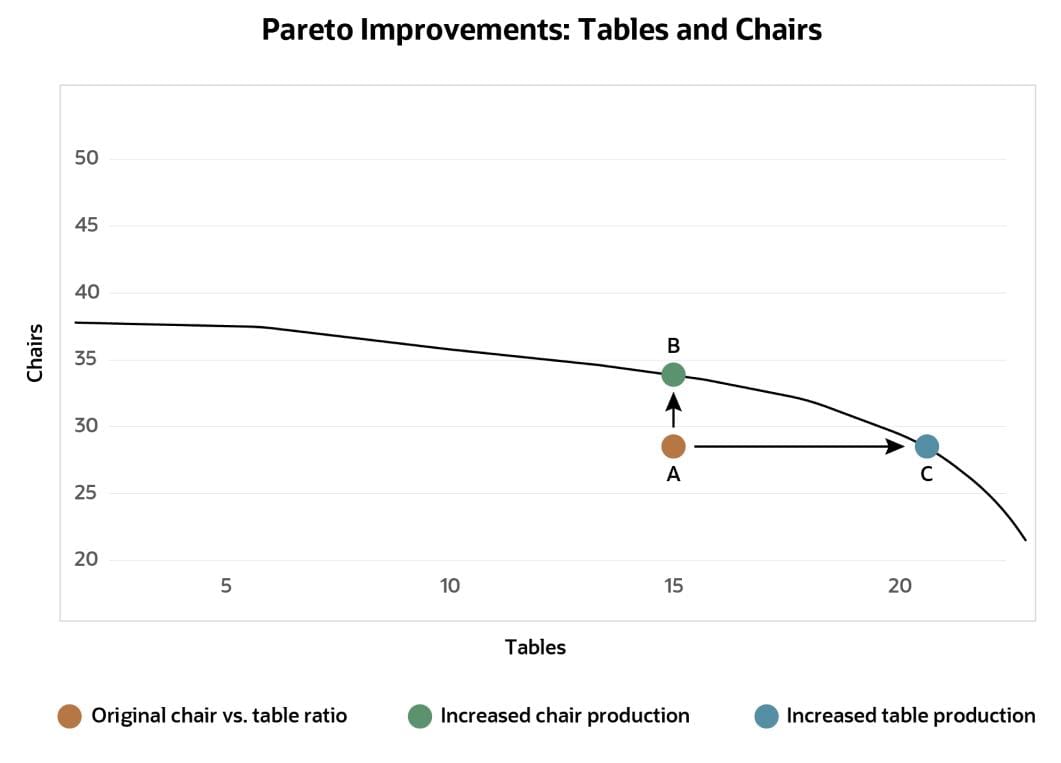What Is Business Efficiency & How Can You Improve It?
Blog Credit: Abby Jenkins , November 17, 2022 (What Is Business Efficiency & How Can You Improve It?)
Inefficient business processes are more than just a time drag. They can put a strain on a company’s profitability, hamper its ability to meet consumer demand and make it harder for employees to do their jobs. Without proper management, small issues that go undetected can mushroom into real problems that, worst case, can put a business in jeopardy. This article explains how to measure business efficiency and explores ways businesses can become more efficient without sacrificing the quality of their products, services and the people behind them.
What Is Business Efficiency?
Business efficiency describes how effectively a company generates products and services related to the amount of time and money needed to produce them. Efficient companies make the most of their resources, transforming labor, materials and capital into products and services that create profit for the company. Inefficient companies, on the other hand, lack organization, which can slow down their operations, waste time and money and impact profitability.
A business that uses common efficiency measures — and takes advantage of techniques to improve efficiencies — can reduce waste across its organization, which often leads to higher profits, a happier and more productive staff, and more satisfied customers.
Key Takeaways
- Businesses can measure their efficiency by evaluating their finances, operations, energy use, labor processes and more.
- Simple changes can make a significant difference, including automating processes and restructuring how employees complete their work.
- Efficiency improvements aren’t one-size-fits-all and must suit a company’s specific needs; proper tracking and analysis is crucial to maximizing long-term efficiency.
Business Efficiency Explained
Businesses are naturally always looking for ways to spend less money while making more. As they seek to improve their operations, many have two common goals: to produce more high-quality products and services without raising costs, and to increase employee productivity without needing to add more staff. The road to improvement begins with a deep analysis of current operations. Internal measures, like monitoring investment returns or analyzing profit margin trends, can help a business identify where its strengths and weaknesses lie in terms of operating as efficiently as possible.
It’s easy to understand how business leaders and decision makers can become enmeshed in day-to-day demands and miss the need to tweak and clean up bigger-picture processes at every level of their companies. For example, a one-day delay in fulfilling a customer’s order due to an inefficient ordering system may not seem like a major problem, but as more orders come in, the delays could pile up and cause bottlenecks in production. Even when sales are still being generated and orders are being fulfilled, if delays grow, customer satisfaction could take a dive, which may eventually lead consumers to turn to competitors.
Even when an organization is running smoothly, improvements can often be made. As technologies get more sophisticated, new hires come on board or suppliers’ terms evolve over time, a business can typically find places to tweak operations to increase efficiency. The need to change can also stem from external forces, like environmental impacts from inefficient waste management or an inability to attract employees in a competitive labor market.
Areas to Improve Business Efficiency
Some business processes may already be optimized for maximum efficiency, while others may need more of a boost. Here’s a look at seven key business functions that companies can analyze to determine how efficient their processes currently are and where they can make improvements.
-
Return on investment (ROI)
One place a company can start evaluating efficiency is by measuring its return on investment (ROI), meaning how much revenue was generated compared with how much it costs to generate that revenue. In addition to analyzing ROI on previous initiatives, the company should evaluate potential ROI on future investments. For example, investing in more new factory equipment that speeds up the production process may increase revenue for the business in the future if it means getting products in the hands of consumers more quickly.
-
Process efficiency
Process efficiency refers to the strength of internal processes. For example, an efficient inventory management process will allow a company to quickly unpack, allocate and use raw materials to produce products that fulfill orders, whereas inefficiencies create bottlenecks and slow down operations. If the allocation is inefficiently managed, for instance, raw materials can pile up in the warehouse — taking up valuable space and increasing carrying costs — while they wait to be used for orders. They will also be hard to find when needed, another time-waster. Inefficiencies at any step in the process often lead to the same outcomes: higher costs for a company and longer wait times for customers.
-
Operational efficiency
Operational efficiency focuses on a company’s core operations — both specific departments and cross-department integration and communication. For example, company data that isn’t centralized or constantly updated can result in inconsistent or faulty decisions and strategies in different areas of the business. Similarly, the longer it takes for qualified sales leads to be handed off to sales, the more likely potential customers will have gone elsewhere. Operational efficiency looks at both internal and external factors for anything that might affect the business outcome.
-
Environmental efficiency
To analyze a company’s environmental efficiency, business officials can measure its carbon footprint and compare its pollution level, energy use, and waste with competitors and environmentally conscious benchmarks. Some businesses perform an internal analysis, while others hire outside analysts to assess their organizations. Sustainable business practices, like using recycled and renewable materials, not only help protect the environment but can also reduce costs. Even if green initiatives are more costly in the short term, they may have a positive influence on the public’s perception of a company and lead to more sales that yield higher returns.
-
Energy efficiency
Companies that use energy-efficient equipment and renewable sources, like solar power, can reduce their energy costs. Businesses may also want to evaluate the amount of energy used during each stage in a product’s lifestyle and find ways to streamline production processes to reduce energy consumption. Making relatively small investments, like installing lights that automatically shut off when corporate offices are empty, can reduce energy usage and lower costs.
-
Labor and productivity efficiencies
Businesses often look for ways to maximize productivity. Automating certain processes, such as payroll and invoicing, with software relieves employees of tedious tasks so they can focus their skills and attention on more strategic, higher-value work. Automation also improves the accuracy of many repetitive tasks, like manual data entry, reducing time spent checking and correcting errors. Setting benchmarks, using the latest technology, and providing proper team management can ensure employees are working efficiently — and that they’re involved in work they find gratifying.
-
Financial efficiency
A company’s financial efficiency is measured by determining what percentage of its revenue is dedicated to expenses. If a company’s expenses are higher than its revenue, it may suffer from financial inefficiencies that need to be addressed. The greater the financial efficiency, the more a business can invest in expansion and other improvements.
How to Improve Business Efficiency
Creating a truly efficient business requires ongoing monitoring and periodic adjustments. Here are 10 strategies for improving business efficiency.
-
Encourage open communication.
While managers may have a good handle on many of a company’s operations, they may not be as familiar as their employees with the many day-to-day details, including any pain points and bottlenecks they experience. Creating a welcoming office environment that fosters open communication can encourage staff to notify managers of any inefficiencies in the workflow — and suggest ways to fix them — before they become major issues. Allowing for an honest dialogue can have an additional benefit of making employees feel like valuable members of the team who have a real stake in the future of the company.
-
Reduce the need for multitasking.
Multitasking may seem more productive and efficient, but over the years studies have shown the opposite to be true. As much as possible, and with the exception of emergencies and urgent problems, giving employees uninterrupted time to focus on one task at a time — rather than jumping from one to another without completing either — can help improve their performance, which in turn can improve the business’s performance.
-
Delegate responsibilities.
Some managers are constantly checking over every detail of their employees’ work. But when two people are essentially doing the job of one, the work can cost a company twice as much and take twice as long. To ensure that staff members at every level of an organization are not duplicating efforts, delegate specific responsibilities and set clear goals tied to specific tasks to avoid redundancies.
-
Keep morale high.
Employee morale is about more than just keeping a well-stocked snack cabinet or throwing the occasional office party. Maintaining high morale is about making sure employees feel that their work and time is valued by the company. If employees don’t see any advancement opportunities, for example, they may not feel any drive to do more than the bare minimum. By providing constructive and positive feedback and rewarding employees for a job well done, leadership can help them feel like an important part of the organization and increase productivity from the ground up. Plus, high morale can help companies retain top talent, which also reduces turnover costs and risks.
-
Make calculated cuts.
It may seem paradoxical, but cutting back on expenses may be necessary to improve business efficiency. While slashing budgets or demanding higher returns from staff without a clear plan can lead to additional problems for an organization, calculated reductions can help modernize a company while increasing efficiency. For example, if a supplier raises its prices, it may be time to find a replacement. Or if consumer demand wanes for a particular product, perhaps it’s time to focus fewer resources on it or retire the product altogether.
-
Minimize meetings.
Meetings are essential to running a business, but not every meeting is essential. Instead of constantly interrupting staff with long meetings, consider scheduling regular brief check-ins to plan out the agenda for the day or even the full week ahead. Even a bunch of short meetings can derail a productive hot streak.In fact, it may be better to schedule them back to back in one day rather than periodically interrupt employees from their tasks at hand.
-
Follow documented practices.
While it’s important to continuously work toward making improvements, don’t assume that an old practice is automatically an outdated one. Developing a handbook that includes tried-and-true methods that have worked in the past can help staff, especially new hires, make sure they’re properly following the correct procedures.Documenting processes also keeps staff on the same page — with each other and with management — so everyone has a common understanding of the work that was done, how it was done and what still needs to be done. Without standard operating procedures, managers might end up spending more time explaining how work should be done than actually managing.
-
Work on your company culture.
A company culture that encourages and incentivizes innovation can lead to higher business efficiency. Unhappy employees are often less productive, so setting goals like helping them achieve a healthy work-life balance can do wonders for their satisfaction. In addition, a successful company culture ensures employees feel safe, respected and free of any discrimination from management and their peers.
-
Spot trends early.
The earlier inefficiencies are identified, the quicker they can be fixed. Digital dashboards, such as those found in real-time enterprise resource planning systems, are valuable tools for spotting them. Dashboards compile key performance indicators (KPIs) in visual formats, such as charts and tables, and can highlight inefficiencies before they become an ongoing, compounded problem. For example, a dashboard may surface a slowdown in the manufacturing process. It could be the result of failing equipment, a manager approving too many employees’ vacation requests for the same week, a combination of both or something else entirely. Whatever the case, dashboards can flag inefficiencies and lead to improvements.
Business Efficiency and Pareto Improvements
When trying to correct an inefficiency, it’s important that a business doesn’t redirect too many resources so as to harm another area. For example, if a business’s accounts receivable (AR) function is running smoothly but accounts payable (AP) is falling behind, moving two staff members from AR to AP can help AP catch up but cause AR to lose ground.
An improvement that benefit one party without harming another is known as a Pareto improvement, named after Italian economist and political scientist Vilfredo Pareto. For example, consider a company that manufactures tables and chairs, both made from the same wood. In a typical week, the company creates 15 tables and 30 chairs. During manufacturing, a worker realized that the technique used to cut wood for a table created more waste than necessary; by changing the process, one extra chair can be created for every three tables made without compromising the quality of any of the products. Alternatively, if the new cutting technique is applied to the chair process, every five chairs can create one new table. The result? The company can now create 15 tables and 35 chairs or 21 tables and 30 chairs. Both are examples of a Pareto improvements, as illustrated below:

Keep in mind that Pareto improvements may not always correct inequities. For example, if a business experiences record profitability and decides to distribute it evenly among every department, no party is harmed or loses money, but not every party will necessarily benefit in the same way. A department already operating under budget may need to spend that money to cover daily obligations, whereas another with budget overflow can invest the money on innovation. When distributing resources, decision makers need to weigh other factors.
Efficiency Looks Different for Each Business
It stands to reason that not every business will require the same efficiency improvements. For example, two competing manufacturers can have similar profit margins but very different expenses. Manufacturer A may have a strong relationship with a shipping company and is able to transport its goods cheaply and quickly, but its revenue may suffer from an unreliable ordering process that leaves it frequently undersupplied on raw materials and unable to process orders. Meanwhile, Manufacturer B may have optimized its ordering process, but if it’s relying on a single vendor for raw materials that’s having its own issues, production can grind to a halt Both companies need to rectify different issues to create a more efficient business.
Efficiency Doesn’t Improve in a Vacuum
In an effort to become more efficient, some businesses fall into a common trap: They don’t consider the potential ripple effects of a process change throughout the company. For example, a more efficient shipping process that gets goods to customers is all well and good, but is the accounts receivable team prepared to send invoices and collect payments more quickly? Is the factory prepared to increase its shipment of raw materials to replace the goods being shipped out at a faster rate? And will speeding up shipment times boost sales, or might it just create more downtime for your staff?
It’s important to regularly check KPIs to measure the effectiveness of efficiency improvements throughout the company, so business leaders can make any necessary adjustments. Monitoring returns, whether manually or through an automated ERP, can help businesses make the most of their efficiency investments.
Business Efficiency FAQs
What makes a business efficient?
A business is efficient if it generates high output, often measured as revenue, compared with the costs it puts into its operations. Efficient businesses make the best use of their resources, including giving their staff time to work on high-level tasks that allow them to provide the best possible experience to customers when delivering products and services.
How does efficiency affect a business?
Efficient businesses run smoothly and waste fewer resources. Staff members maximize their time, and investments yield high returns, allowing a business to continue to grow and earn more revenue.
What is the difference between business efficiency and business effectiveness?
Business effectiveness is how well a company accomplishes its primary tasks, namely producing goods or services. If a business is effective but inefficient, it consistently delivers its goods but accrues waste or operates with unnecessarily high costs. An efficient business makes the most of its resources, with cost savings and higher profit to show for it.
What do you mean by business efficiency?
Business efficiency measures the relationship between output and input. A company’s level of efficiency may be measured by examining its productivity, return on investment, energy usage, environmental impact and other measures.
What is an example of efficiency in business?
A retail store operates efficiently if it maintains the appropriate amount of stock to meet demand without overstocking. Another example is if it schedules just enough staff to mind the store, assist customers and check them out.
How can a business improve efficiency?
Businesses can improve efficiency by automating tedious work, creating a company culture that focuses on ensuring workers are happy, reducing distractions, increasing communication, properly delegating responsibilities and more. It’s important to monitor efficiency improvements to stick with what works for a company and adjust what doesn’t.
Why is business efficiency important?
If a company is inefficient, it will continue to waste resources, which could lead to decreased profitability. As a company grows, inefficiencies can compound, which can push both employees and customers away, leading to financial losses. Correcting inefficiencies can help a company thrive.
Deliver More ERP Value with Circular Edge
We’ve been helping customers overcome obstacles to deliver more business value for more than 20 years. Let us show you how to leverage Circular Edge’s expertise in advisory, consulting, managed services and business solutions along with our global team of 250+ multi-skilled resources to realize better insights, organizational efficiency, increased profitability and improved relationships with your suppliers and customers – and ultimately take your business to the next level.
"*" indicates required fields












